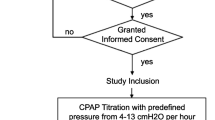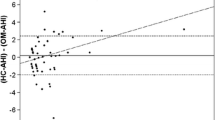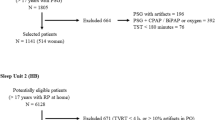Abstract
Purpose
Positive airway pressure (PAP) devices have been widely used as the first line of treatment in obstructive sleep apnea (OSA). Most advanced PAP devices support the estimation of respiratory index (RI) using the patient’s mask airflow. In addition to the compliance factor for PAP device use, which is important for monitoring patient sleep health, RI is also becoming important for monitoring. However, there are few reports that validate RI of a PAP device with polysomnography.
Methods
Between January 2015 and December 2017, 50 participants were enrolled who were diagnosed with OSA and prescribed auto-titration PAP (APAP) devices. The RIs of participants were measured at night using APAP devices, concurrently with electroencephalography, respiratory inductance plethysmography sensors, and other polysomnographic sensors in a sleep laboratory. The respiratory-related data of APAP were prospectively analyzed with the manually scored polysomnographic data.
Results
The apnea-hypopnea index and apnea index showed a statistically close relationship between the auto-scored respiratory data from the APAP device and the manually scored respiratory data from polysomnographic sensors. Obstructive apnea and central apnea indices showed relatively low correlations. The differences between the auto-scored RI and manually scored RI were influenced by BMI, waist circumference, weight, oxygen saturation, and respiratory distress indices of diagnostic polysomnographic factors.
Conclusions
The RIs of APAP devices have a tendency to be underestimated or mismatched when compared with polysomnography. Sleep specialists are advised to consider additional anthropometric and diagnostic factors to account for these differences during PAP treatment.



Similar content being viewed by others
References
Young T, Peppard PE, Gottlieb DJ (2002) Epidemiology of obstructive sleep apnea: a population health perspective. Am J Respir Crit Care Med 165(9):1217–1239
Donovan LM, Kapur VK (2016) Prevalence and characteristics of central compared to obstructive sleep apnea: analyses from the Sleep Heart Health Study Cohort. Sleep 39(7):1353–1359
Asha'ari ZA, Hasmoni MH, Ab Rahman J, Yusof RA, Ahmad RA (2012) The association between sleep apnea and young adults with hypertension. Laryngoscope 122(10):2337–2342
Naughton MT, Kee K (2017) Sleep apnoea in heart failure: to treat or not to treat? Respirology 22(2):217–229
Marshall NS, Wong KK, Cullen SR, Knuiman MW, Grunstein RR (2014) Sleep apnea and 20-year follow-up for all-cause mortality, stroke, and cancer incidence and mortality in the Busselton Health Study cohort. J Clin Sleep Med 10(4):355–362
Marshall NS, Wong KK, Liu PY, Cullen SR, Knuiman MW, Grunstein RR (2008) Sleep apnea as an independent risk factor for all-cause mortality: the Busselton Health Study. Sleep 31(8):1079–1085
Epstein LJ, Kristo D, Strollo PJ, Friedman N, Malhotra A, Patil SP, Ramar K, Rogers R, Schwab RJ, Weaver EM, Weinstein MD, null (2009) Clinical guideline for the evaluation, management and long-term care of obstructive sleep apnea in adults. J Clin Sleep Med 5(3):263-276
Kapur VK, Auckley DH, Chowdhuri S, Kuhlmann DC, Mehra R, Ramar K, Harrod CG (2017) Clinical practice guideline for diagnostic testing for adult obstructive sleep apnea: an American Academy of Sleep Medicine Clinical Practice Guideline. J Clin Sleep Med 13(3):479–504
Pepin JL, Bailly S, Tamisier R (2019) Big Data in sleep apnoea: opportunities and challenges. Respirology 25:486–494. https://doi.org/10.1111/resp.13669
Patil SP, Ayappa IA, Caples SM, Kimoff RJ, Patel SR, Harrod CG (2019) Treatment of adult obstructive sleep apnea with positive airway pressure: an american academy of sleep medicine systematic review, meta-analysis, and GRADE Assessment. J Clin Sleep Med 15(2):301–334
Patil SP, Ayappa IA, Caples SM, Kimoff RJ, Patel SR, Harrod CG (2019) Treatment of adult obstructive sleep apnea with positive airway pressure: an American Academy of Sleep Medicine Clinical Practice Guideline. J Clin Sleep Med 15(2):335–343
Weaver TE, Grunstein RR (2008) Adherence to continuous positive airway pressure therapy: the challenge to effective treatment. Proc Am Thorac Soc 5(2):173–178
Park do Y, Kim HJ, Kim CH, Kim YS, Choi JH, Hong SY, Jung JJ, Lee KI, Lee HS (2015) Reliability and validity testing of automated scoring in obstructive sleep apnea diagnosis with the Embletta X100. Laryngoscope 125(2):493–497
Berry RB, Budhiraja R, Gottlieb DJ, Gozal D, Iber C, Kapur VK, Marcus CL, Mehra R, Parthasarathy S, Quan SF, Redline S, Strohl KP, Davidson Ward SL, Tangredi MM (2012) Rules for scoring respiratory events in sleep: update of the 2007 AASM Manual for the Scoring of Sleep and Associated Events. Deliberations of the Sleep Apnea Definitions Task Force of the American Academy of Sleep Medicine. J Clin Sleep Med 8(5):597–619
Desai H, Patel A, Patel P, Grant BJ, Mador MJ (2009) Accuracy of autotitrating CPAP to estimate the residual Apnea-Hypopnea Index in patients with obstructive sleep apnea on treatment with autotitrating CPAP. Sleep Breath 13(4):383–390
Berry RB, Kushida CA, Kryger MH, Soto-Calderon H, Staley B, Kuna ST (2012) Respiratory event detection by a positive airway pressure device. Sleep 35(3):361–367
Cilli A, Uzun R, Bilge U (2013) The accuracy of autotitrating CPAP-determined residual apnea-hypopnea index. Sleep Breath 17(1):189–193
Gagnadoux F, Pevernagie D, Jennum P, Lon N, Loiodice C, Tamisier R, van Mierlo P, Trzepizur W, Neddermann M, Machleit A, Jasko J, Pepin JL (2017) Validation of the system one RemStar auto A-Flex for Obstructive Sleep Apnea Treatment and Detection of Residual Apnea-Hypopnea Index: a European Randomized Trial. J Clin Sleep Med 13(2):283–290
Denotti AL, Wong KK, Dungan GC 2nd, Gilholme JW, Marshall NS, Grunstein RR (2012) Residual sleep-disordered breathing during autotitrating continuous positive airway pressure therapy. Eur Respir J 39(6):1391–1397
Camilo MR, Machado LA, Castilho CM, Sander HH, Eckeli AL, Fernandes RF, Leite JP, Pontes-Neto OM (2020) Diagnostic accuracy of positive airway pressure device for sleep apnea detection in acute stroke patients. Stroke 51(1):324–326
Kim DE, Hwangbo Y, Bae JH, Yang KI (2015) Accuracy of residual apnea-hypopnea index obtained using the continuous positive airway pressure device: application of new version 2.0 scoring rules for respiratory events during sleep. Sleep Breath 19(4):1335–1341
Herkenrath SD, Treml M, Anduleit N, Richter K, Pietzke-Calcagnile A, Schwaibold M, Schafer R, Alshut R, Grimm A, Hagmeyer L, Randerath WJ (2019) Extended evaluation of the efficacy of a proactive forced oscillation technique-based auto-CPAP algorithm. Sleep Breath 24:825–833. https://doi.org/10.1007/s11325-019-01901-8
Lorenzi-Filho G, Almeida FR, Strollo PJ (2017) Treating OSA: Current and emerging therapies beyond CPAP. Respirology 22(8):1500–1507
Piper AJ (2020) Advances in non-invasive positive airway pressure technology. Respirology 25(4):372–382
Funding
This was not an industry-supported study. This work was supported by the National Research Foundation of Korea Grant funded by the Korean Government (2017R1E1A1A01074543) and the Korean Health Technology R&D Project, Ministry of Health & Welfare, Republic of Korea (HC15C3415). The funders had no role in study design, data collection and analysis, decision to publish, or preparation of the manuscript.
Author information
Authors and Affiliations
Corresponding author
Ethics declarations
Conflict of interest
The authors declare that they have no conflict of interest.
Ethical approval
All procedures performed in the studies involving human participants were in accordance with the ethical standards of the institutional and/or national research committee and with the 1964 Helsinki declaration and its later amendments or comparable ethical standards.
Informed consent
Informed consent was obtained from all individual participants included in the study.
Additional information
Comment
This study demonstrates to considerable inadequacy and lack of validity of current "AHI" measures, as determined by machine algorithm. The issues of leak, and possible under/over therapy are crucial. These machine-derived events are, in reality, "Airflow Limited Events". They should be described as such. The ALE is not an AHI!!! Without measure of plethysmography, EEG determined sleep or saturation, the value of these observations, is helpful, but not a valid measure for clinically complex patients. This paper makes a very important contribution to our understanding of machine determined algorithms, versus gold standard measure. I applaud the authors.
David Joffe
NSW, Australia
Publisher’s note
Springer Nature remains neutral with regard to jurisdictional claims in published maps and institutional affiliations.
Supplementary Information
ESM 1
(DOCX 10479 kb)
Rights and permissions
About this article
Cite this article
Park, DY., Gu, G., Han, J.G. et al. Validating respiratory index of auto-titrating positive airway pressure device with polysomnography. Sleep Breath 25, 1477–1485 (2021). https://doi.org/10.1007/s11325-020-02278-9
Received:
Revised:
Accepted:
Published:
Issue Date:
DOI: https://doi.org/10.1007/s11325-020-02278-9




